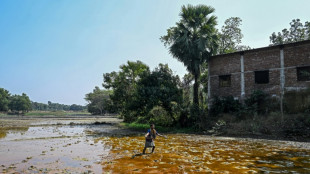
-
 Brazil binman finds newborn baby on garbage route
Brazil binman finds newborn baby on garbage route
-
US senator smashes record with marathon anti-Trump speech

-
 Trump advisor Waltz faces new pressure over Gmail usage
Trump advisor Waltz faces new pressure over Gmail usage
-
Niger junta frees ministers of overthrown government

-
 Trump set to unleash 'Liberation Day' tariffs
Trump set to unleash 'Liberation Day' tariffs
-
Boeing chief to acknowledge 'serious missteps' at US Senate hearing

-
 Real Madrid hold Real Sociedad in eight-goal thriller to reach Copa del Rey final
Real Madrid hold Real Sociedad in eight-goal thriller to reach Copa del Rey final
-
Nuno salutes 'special' Elanga after stunning strike fires Forest

-
 PSG survive scare against Dunkerque to reach French Cup final
PSG survive scare against Dunkerque to reach French Cup final
-
Sundowns edge Esperance as crowd violence mars quarter-final

-
 Nottingham Forest beat Man Utd, Saka scores on Arsenal return
Nottingham Forest beat Man Utd, Saka scores on Arsenal return
-
Elanga wonder-goal sinks Man Utd as Forest eye Champions League berth

-
 Stock markets mostly advance ahead of Trump tariffs deadline
Stock markets mostly advance ahead of Trump tariffs deadline
-
US movie theaters urge 45-day 'baseline' before films hit streaming

-
 Saka scores on return as Arsenal beat Fulham
Saka scores on return as Arsenal beat Fulham
-
Third-division Bielefeld shock holders Leverkusen in German Cup

-
 Ball-blasting 'Torpedo bats' making waves across MLB opening weekend
Ball-blasting 'Torpedo bats' making waves across MLB opening weekend
-
Newsmax shares surge more than 2,000% in days after IPO

-
 Thousands of Hungarians protest against Pride ban law
Thousands of Hungarians protest against Pride ban law
-
GM leads first quarter US auto sales as tariffs loom

-
 Tesla sales tumble in Europe in the first quarter
Tesla sales tumble in Europe in the first quarter
-
No 'eye for an eye' approach to US tariffs: Mexico

-
 NFL club owners back dynamic kickoffs, delay tush push vote
NFL club owners back dynamic kickoffs, delay tush push vote
-
Trump 'perfecting' new tariffs as nervous world braces

-
 Trump nominee says to press UK on Israel arms
Trump nominee says to press UK on Israel arms
-
French court says Le Pen appeal ruling could come before presidential vote

-
 The battle to control assets behind Bosnia crisis
The battle to control assets behind Bosnia crisis
-
Prabhsimran powers Punjab to IPL win over Lucknow

-
 Mass layoffs targeting 10,000 jobs hit US health agencies
Mass layoffs targeting 10,000 jobs hit US health agencies
-
Tiger's April Foolishness: plan to play Masters just a joke

-
 Myanmar quake toll passes 2,700, nation halts to honour victims
Myanmar quake toll passes 2,700, nation halts to honour victims
-
Turkish fans, artists urge Muse to cancel Istanbul gig

-
 US seeks death penalty for accused killer of insurance CEO
US seeks death penalty for accused killer of insurance CEO
-
UK govt moves to block sentencing guidelines for minority defendants

-
 Trump puts world on edge as 'Liberation Day' tariffs loom
Trump puts world on edge as 'Liberation Day' tariffs loom
-
Swedish journalist jailed in Turkey kept 'isolated': employer

-
 Stock markets advance ahead of Trump tariffs deadline
Stock markets advance ahead of Trump tariffs deadline
-
Gulf between Everton and Liverpool has never been bigger, says Moyes

-
 Finland to withdraw from anti-personnel mine ban treaty
Finland to withdraw from anti-personnel mine ban treaty
-
UK vows £20 million to boost drone and 'flying taxi' services

-
 Ford's US auto sales dip in first quarter as tariffs loom
Ford's US auto sales dip in first quarter as tariffs loom
-
Digging for box office gold, 'A Minecraft Movie' hits cinemas

-
 Southampton boss Juric desperate to avoid Premier League 'worst team' tag
Southampton boss Juric desperate to avoid Premier League 'worst team' tag
-
Thailand rescue dogs double as emotional support

-
 Five takeaways from Marine Le Pen verdict
Five takeaways from Marine Le Pen verdict
-
Stock markets split ahead of Trump tariffs deadline

-
 Turkish fans, artists urge Muse to cancel Istanbul gig over protest dispute
Turkish fans, artists urge Muse to cancel Istanbul gig over protest dispute
-
Former captain Edwards named new England women's cricket coach

-
 Haaland ruled out for up to seven weeks: Man City boss Guardiola
Haaland ruled out for up to seven weeks: Man City boss Guardiola
-
UK Supreme Court opens car loans hearing as banks risk huge bill


Homo erectus, not sapiens, first humans to survive desert: study
Our ancestor Homo erectus was able to survive punishingly hot and dry desert more than a million years ago, according to a new study that casts doubt on the idea that Homo sapiens were the first humans capable of living in such hostile terrain.
The moment when the first members of the extended human family called hominins adapted to life in desert or tropical forests marks "a turning point in the history of human survival and expansion in extreme environments," lead study author Julio Mercader Florin of the University of Calgary told AFP.
Scientists have long thought that only Homo sapiens, who first appeared around 300,000 years ago, were capable of living sustainably in such inhospitable regions.
The first hominins to have split off from the other great apes were believed to be limited to less hostile ecosystems, such as forest, grasslands and wetlands.
One of the world's most important prehistoric sites, Olduvai Gorge in modern-day Tanzania, was thought to home to those easier types of landscapes.
But this steep ravine in East Africa's Great Rift Valley, which has played a key role in the understanding of human evolution, was actually a desert steppe, according to the study published in the journal Communications Earth & Environment on Thursday.
After collecting archaeological, geological and palaeoclimatic data, the international team of researchers were able to reconstruct the gorge's ecosystem over the years.
Fossilised pollen of the Ephedra shrub -- which commonly lives in arid areas -- as well as traces of past wildfires and signs in the soil show there was an extreme drought in the area between one and 1.2 million years ago.
- Homo erectus: underestimated? -
Evidence collected from the Engaji Nanyori site in the gorge suggests that Homo erectus adapted to this hostile environment "by focusing on ecological focal points such as river confluences where water and food resources were more predictable", Mercader Florin said.
"Their ability to repeatedly exploit these focal points... and adapt their behaviours to extreme environments demonstrates a higher level of resilience and strategic planning than previously assumed."
Specialised tools found at the site, such as hand axes, scrapers and cleavers, showed that Homo erectus had also worked out how to process animal carcasses.
The bones of animals such as cows, hippopotamuses, crocodiles and antelopes also had cut marks, indicating they had been skinned and had their bone marrow extracted.
"This suggests they optimised their resource use to adapt to the challenges of arid environments, where resources were scarce and needed to be exploited fully," Mercader Florin said.
"Our findings show that Homo erectus was capable of surviving long term in extreme environments characterised by low density of food resources, navigational challenges, very low/very high plant life, temperature/humidity extremes, and the need for high mobility," he added.
"This adaptability expands Homo erectus's potential range into the Saharo-Sindian region across Africa and into similar environments in Asia."
O.Johnson--AMWN


